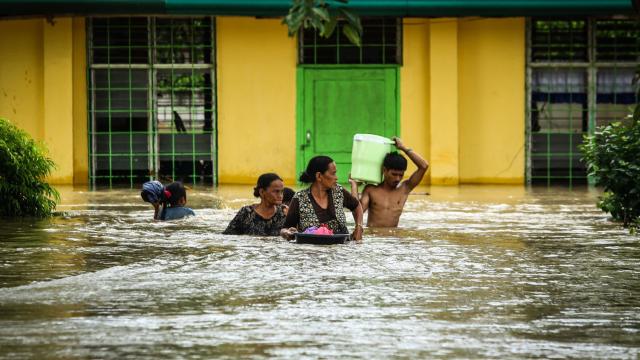If you asked me to guess the top three countries impacted by the climate crisis, I’d probably choose three countries in the Global South. I might guess the Philippines because it’s seen such bad typhoons in recent years. Maybe I’d say Uganda because it’s had such awful drought seasons, or Yemen because its water shortages have gotten so much worse.
I probably wouldn’t guess Germany. But according to a new report released Wednesday, Germany ranks third among countries affected most by the impacts of extreme weather in 2018. Germanwatch’s 2020 Global Climate Risk Index found that the three countries most affected by extreme weather in 2018 were Japan, the Philippines and, yup, Germany.
The authors examined the impacts of floods, storms, heatwaves, and other extreme weather on a variety of socioeconomic factors, from the number of lives lost to the number of dollars in damage sustained over the course of 2018. They then crunched the numbers to create this year’s index (which, it should be noted, doesn’t even begin to incorporate slower impacts of the climate crisis like sea level rise, ice melting, and ocean acidification).
In 2018, Japan saw heavy rainfall that caused the Typhoon Jebi.
All these climate disasters killed a combined 1,282 people. Typhoons and rainfall-induced landslides in the Philippines killed 455 people altogether. And Germany saw heavy rain and heat waves that killed 1,246.
The report also delves into the past two decades of climate-related disasters. It breaks out Puerto Rico from the rest of the U.S., and finds it tops the index, though it’s hardly alone in its suffering.
“Altogether, about 495,000 people died as a direct result of more than 12,000 extreme weather events globally and losses between 1999 and 2018 amounted to around $US3.54 ($5) trillion (in purchasing power parities),” the report says.
In short, people all over the world have gotten fucked over. Crucially, though, these results show that developing countries are far and away bearing the worst impacts. In poorer countries, climate-related shocks can last longer in developing countries even though richer countries tend to suffer higher losses monetarily.
To emphasise these differences, the report looks at not only absolute impacts but also impacts relative to economic power and population. The authors call for a focus on these kinds of climate injustices at the United Nation’s international climate talks, known as COP25, taking place in Madrid over the next two weeks.
“So far, there is a lack of political and legal rules to determine how those responsible for climate change should pay for the consequences of their emissions” the report notes. “In the context of the UN climate negotiations, additional financial resources to help the poorest people and countries cope with loss and damage are lacking.”
Just last week, a UN report called on the world’s most developed countries to take the lead on climate action because they contribute some 78 per cent of all global greenhouse gas emissions. The Germanwatch report shows that richer countries shouldn’t just curb emissions out of some sense of altruism. When it comes to the climate crisis, rich countries aren’t safe.
“High-income countries are feeling climate impacts more clearly than ever before,” it says. “Effective climate change mitigation is therefore in the self interest of all countries worldwide.”
Of course, all people in a country aren’t hit the same way by extreme weather. While even rich white people can get killed by storms, these events have a way of exposing hideous inequality. For instance, the report notes that people who work outside in agriculture or construction face higher risks to their health during heatwaves.
“This is why adaptation measures should especially support the poor and vulnerable and must avoid maintaining and enhancing social injustices and power imbalances,” the report says.
That may not be easy, but with stakes like these, there’s really no other ethical choice.
